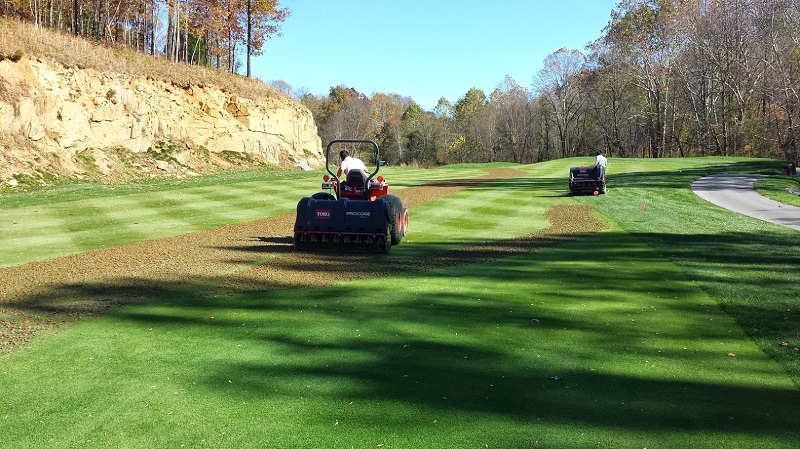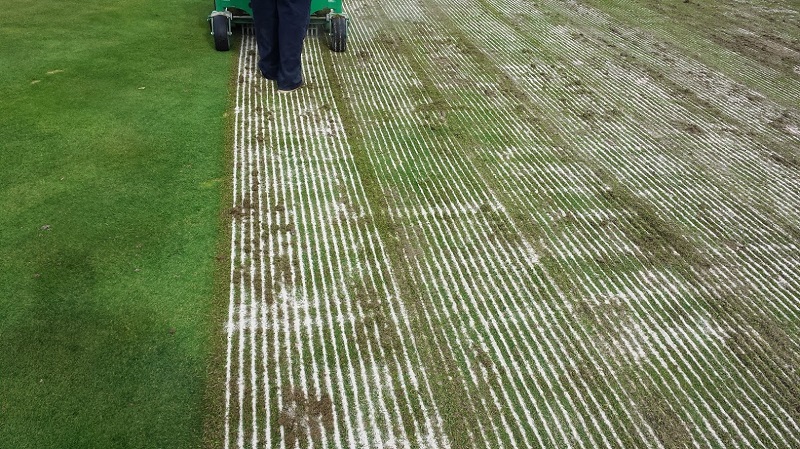Cultivation involves disturbing the soil or thatch using various methods to achieve important agronomic goals: compaction relief, thatch/organic matter reduction, and improved water and air exchange. However, cultivation can require significant time for recovery, thus disrupting play, and should be used judiciously. Cultivation frequency should be based on traffic intensity, level of soil compaction, and the amount of accumulation of excessive thatch and organic matter, which reduces root growth, encourages disease, and creates undesirable playing conditions. Cultivation techniques include core aeration, deep drilling, verticutting, grooming, solid tining, and spiking/slicing. The table below lists these cultivation approaches and presents a relative ranking of the agronomic benefits of each (republished with permission from Environmental Best Management Practices for Virginia’s Golf Courses, Table 7-4, p. 94):
Turfgrass Cultivation Methods and Rankings of Agronomic Benefits
| Method | Compaction Relief | Thatch control | Water/air movement | Disruption of play |
|---|---|---|---|---|
| Core aeration | High | Good | High | Medium to high |
| Deep drilling | Medium | Low | High | High |
| Verticutting | Low | Best | Medium | Low to high |
| Grooming | None | Very low | Very low | None |
| Solid tining | Low | None | High | Medium-low |
| Spiking/slicing | None | Very low | Low | None |
Core aeration is effective at managing soil compaction and aiding in improvement of soil drainage by removing small cores or plugs from the soil profile. Cores are usually 0.25 to 0.75 inches in diameter. Using bigger tines and therefore removing larger cores will disrupt play for longer.
Deep-drill aeration creates deep holes in the soil profile through use of drill bits. Soil is brought to the surface and distributed into the canopy. Holes can be backfilled with new root-zone materials if a drill-and-fill machine is used. These machines allow replacement of heavier soils with sand or other materials in an effort to improve water infiltration into the soil profile.
Vertical mowing (verticutting) can be incorporated into a cultural management program to achieve a number of goals. The grain of a putting green can be reduced by setting a verticutter to a depth that just nicks the surface of the turf. Deeper penetration of knives will stimulate new growth by cutting through stolons and rhizomes while removing accumulated thatch. Deep verticutting (0.5 to 1 inch depth) removes a greater amount of thatch than core aeration and can be considered for aggressive thatch removal as it can remove up to 15% of the thatch at one time. However, it is aggressive and should only be done during less stressful times (e.g., cooler temperatures) and on well-rooted turf. Unlike deep verticutting, shallow verticutting (0.5 inches or less) does not remove thatch. Instead, it severs stolons to promote new growth while also standing up blades for removal of old growth and minor canopy thinning. Shallow verticutting can be practiced regularly during the growing season except in times of drought or excessive heat.
Groomers, or miniature vertical mowers attached to the front of reels, are effective at improving management of grain and improving plant density through the cutting of stolons, but provide very low/no compaction or thatch relief.
Solid tining causes less disturbance to the turf surface and can be used to temporarily reduce compaction and soften surface hardness during months when the growth rate of grasses is reduced. However, the benefits of solid-tine aeration are temporary because no soil is removed from the profile, except when using a deep tine aerator with a “kicking action” that results in some soil loosening. “Venting” or “needle-tining” is often used to describe the practice of solid tine aeration using small-diameter tines (0.25 to 0.375 inches). This is an effective tool that can be used to help provide increased gas exchange to root systems and can be particularly useful in alleviating summer stress on putting greens. It can also be performed with minimal impact on putting surface quality when followed by mowing or rolling.
Best Management Practices
- Annual core aeration programs should be designed to remove 15% to 20% of the surface area. High-traffic areas may require a minimum of two to four core aerations annually.
- Core aeration should take into account when weeds are germinated and should be conducted only when grasses are actively growing and not under stress in order to aid in the quick recovery of surface density.
- Vary the depth of aeration events by incorporating different lengths of tines. This prevents the development of compacted layers in the soil profile.
- Verticutting depth for thatch removal should reach the bottom of the thatch layer and extend into the surface of the soil beneath the thatch.
- Solid tines cause less disturbance to the turf surface and can be used to temporarily reduce compaction and to soften surface hardness during months when the growth rate of grasses is reduced. Benefits of solid-tine aeration are temporary because no soil is removed from the profile.
- Solid tine aeration should be avoided on wet native soils because it causes compaction and reduction in water movement.
- Venting should be periodically performed to help provide oxygen to root zones, particularly prior to the onset of summer stress, and can also help dry out excessively wet soils.

Aeration manages soil compaction and aids in improvement of soil drainage by removing small cores or plugs from the soil profile. Photo credit: Chris Harriman.

Vertical mowing (verticutting) can be incorporated into a cultural management program to achieve a number of goals. Photo credit: Chris Harriman.
Next: Topdressing

